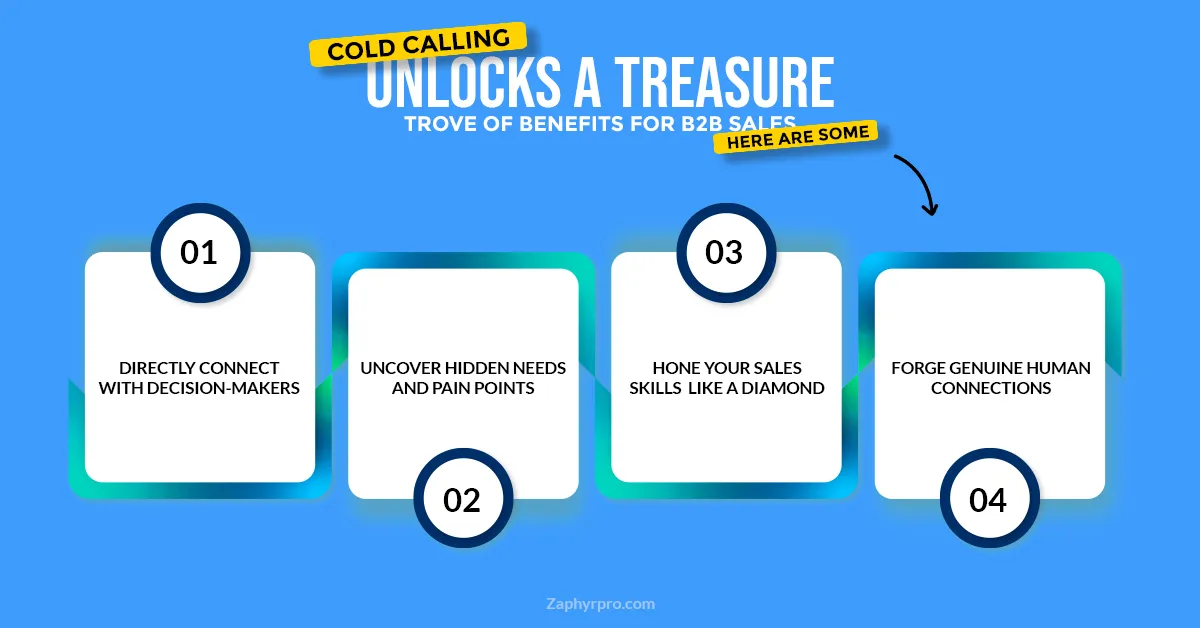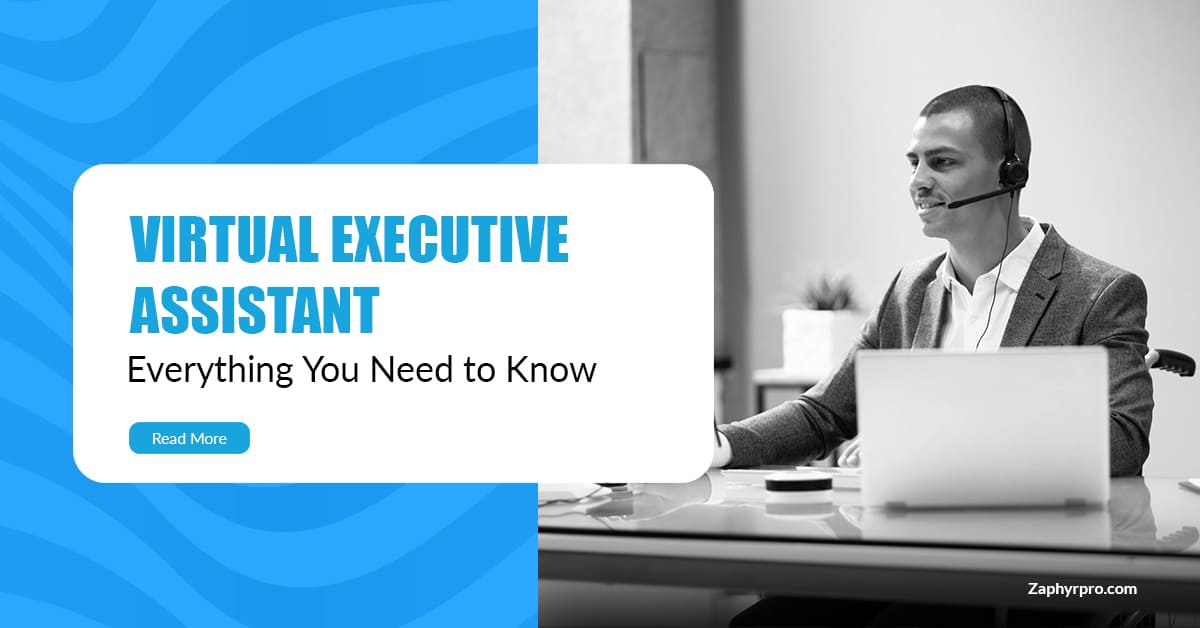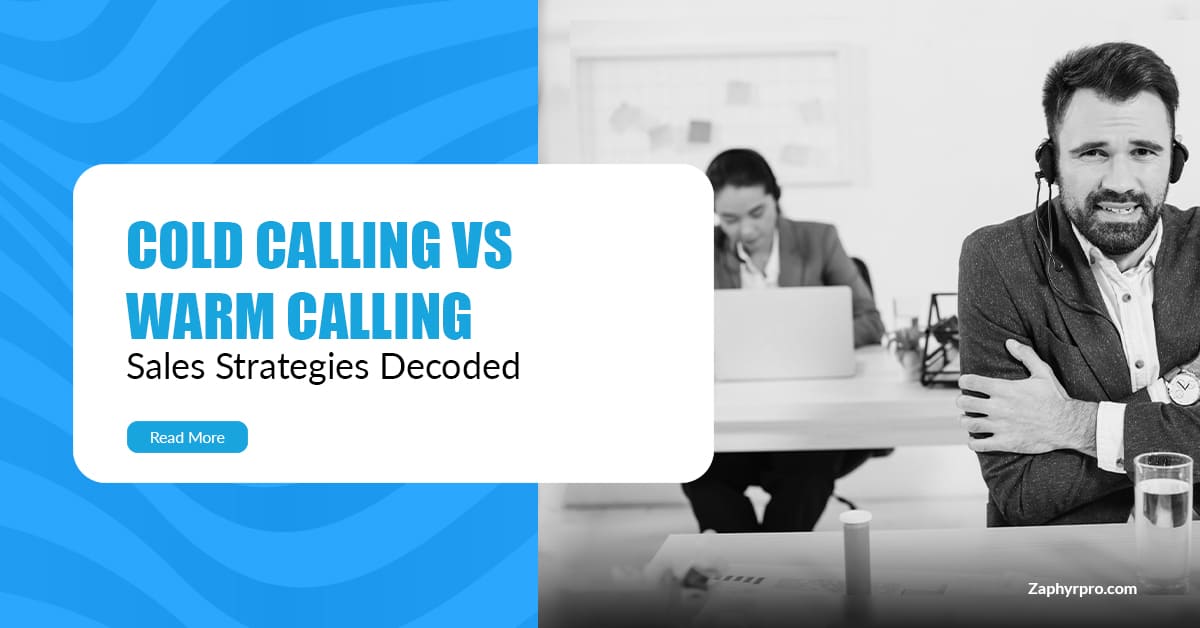Even in the digital age, cold calling remains to be an incredibly effective tool for driving business growth and reaching potential customers. Yes, in this ever-evolving digital world, cold calling might sound old-fashioned to many, but the results it generates are simply exemplary. It is one of the most cost-effective activities to increase sales and generate more revenue.
Apart from being cost-effective and persuasive, cold calling can be outsourced to specialized organizations so that you can focus on tasks that you find easy. This previous sentence must give you an idea of the level of difficulty that cold calling is associated with. Yes, it is very effective, but all good things come at a cost, and the cost of winning potential clients can be frustration. That is why sales professionals who practice cold calling must be extremely patient while carrying out this powerful activity.
There is a difference between cold calling and warm calling, and these two are often mistaken for each other. But the concept is somewhat the same and can be studied in detail over here.
This blog contains some real-world tips and the advantages of cold calling.
What is Cold Calling in Sales?
Cold calling is the process of contacting potential customers who don’t know anything about your product or service. This means that you, being a sales professional, call a prospect who hasn’t interacted with you before and has shown no interest in your product or service prior to the phone call.
Key features of cold calling:
- Unsolicited contact: Prior to the phone call, the prospect hasn’t shown any interest in or requested information about the product or service.
- Phone-based: The customary way is the phone call, but it can also include emails and in-person approaches.
- Focus on building relationships: The primary objective is to establish contact, get to know the prospect’s requirements, and validate them as a potential lead.
- Challenging but potentially rewarding: Rejection can be tough to swallow for sales professionals, but if cold calling is done successfully, it results in priceless leads and sales.
Here are some examples of cold calling:
- A salesperson contacting businesses to offer accounting software.
- A realtor calling homeowners to list their real estate.
- A CPA calling individuals to offer tax services.
What is B2B Cold Calling?
In B2B cold calling, the sales professional targets other businesses instead of individuals. It’s basically the same as regular cold calling, but some techniques differ and goals are tailored according to the business context.
Key features of B2B cold calling:
- Targeting businesses: Salespersons contact key people and decision-makers within companies.
- Focus on solving business problems: The value proposition and pain points are centered around businesses rather than individuals.
- Longer sales cycle: The decision-making processes are intricate and involve multiple stakeholders.
- Building relationships with multiple contacts: Usually, it requires creating bonds with different people within an organization.
Here are some examples of B2B cold calling:
- A sales professional contacting a marketing agency to offer project management services.
- A cybersecurity firm calling a bank to offer data protection solutions.
- A recruitment agency calling a startup to offer onboarding services.
Why is Cold Calling Done by Sales Professionals?
In this age of digital marketing and social selling, why do sales professionals still go cold calling? There are several reasons for this, and here are some key points:

Cold Calling Advantages in B2B Sales
Cold calling in B2B, while a challenge, unlocks hidden gems: faster conversions by directly reaching key decision-makers, identifying high-potential clients through their responses, honing your sales skills in real-time, uncovering unique needs beyond email outreach, and forging valuable human connections that build trust and solidify deals.
Direct access: Decision-makers can miss the emails and social media outreach, but with cold calling, it is possible to reach them.
Relationship building: When you initiate a valuable relationship with prospects, cold calls convert into warm leads.
Uncover hidden needs: Uncover challenges that potential customers weren’t aware of before and provide tailored solutions.
Faster lead generation: Possibly generate leads faster than solely digital methods.
High-value deals: There is a high probability of closing exquisite deals.
Cold Calling Disadvantages in B2B Sales
Yes, cold calling can be a priceless tool in B2B sales, but it also has some major demerits:
High rejection rates: Rejections make cold calling a bumpy ride.
Time-consuming: Making numerous calls with low conversions can be time-consuming.
Negative perception: Spammy strategies by some have damaged its reputation.
Reaching decision-makers: Decision-makers are very busy, so that is a big hurdle too.
Limited information: Relying on raw data can lead to erroneous pitches.
Strong skills required: Every salesperson cannot thrive under pressure.
Overreliance: If you neglect other channels, it can lead to a limited reach.
What are the 3 C’s of Cold Calling?
Here are two common takes on the three C’s of cold calling:
Clear, Concise, and Compelling:
- Clear: Conveying your value proposition and purpose directly and quickly. Be understandable to the listener and avoid jargon.
- Concise: Keeping the message to the point and short. By focusing on the most relevant information, you respect the prospect’s time.
- Compelling: Highlighting the advantages of your product or service to address the target’s specific needs. Generate interest and spark curiosity.
Company, Contact, and CRM:
- Company: Conduct in-depth research on the target company, its industry, needs, size,and challenges. Knowledge of their situation helps tailor your pitch and value proposition.
- Contact: Identify the key person with authority in the company. Connecting with this important decision-maker helps you save time and boosts your chances of success.
- CRM: Employ a customer relationship management (CRM) program to record call notes, track interactions, and manage your pipeline effectively. It helps in follow-ups and avoiding duplicating efforts.
Conclusively, the most efficient “3 C’s” depend on our particular approach and sales technique. To some, Confidence, Consistency, and Credibility might be the perfect “3 C’s” while to others, Compliance, Connection, and Conversion are the best fit.
The sales professional must focus on understanding the core principles behind each interpretation and enforcing them methodically to increase the effectiveness of their cold calling process. But constant things such as thorough preparation, a clear value proposition, and a targeted approach have to be incorporated regardless of the specific “C’s” you choose.
Is Cold Calling Dead Or Does it Still Work for B2B Sales?
There is a myth in this modern landscape that cold calling is dead. However, this is not true. B2B cold calling is pretty much alive, although with a modern twist.
Here’s the deal:
Cold calling isn’t dead, it’s evolved:
Spammy tactics are passé: The same scripts and pitches don’t work anymore. This is the era of personalization. Customized conversations involving the understanding of the specific demands of each potential customer and the offering of tailored solutions make modern cold calling effective.
Technology is the new sidekick: The utilization of automated call dialing, CRM systems, and AI-powered assistants streamlines processes and makes cold calling more effective.
Quality trumps quantity: Concentrating on reaching the appropriate people, creating genuine bonds, and providing real value is key to success.
So, does it still work for B2B sales? Absolutely!
Direct reach: It’s a robust way to directly connect with decision-makers and key people who might not be easily reachable through other channels.
Building relationships: The human touch of a conversation helps establish understanding and trust, which is vital for B2B relationships.
Uncovering hidden needs: Cold calls can uncover needs and challenges that potential customers might not even be aware of, building opportunities for you to fill the gap.
Is Cold Calling Illegal for B2B Sales?
Myth buster: Can you cold call B2B leads? Absolutely! but certain regulations and restrictions exist, which you should be aware of. The Telemarketing Sales Rule allows B2B outreach to businesses. Just steer clear of personal cell phones and respect “do not call” requests, as the TSR kicks in there. It’s like driving a car—it’s doable, but you need to follow the traffic rules!
Legality:
Telemarketing Sales Rule (TSR) in the US: This directive regulates telemarketing calls to individuals but does not include B2B calls made to businesses or commercial entities. So calling other companies is generally fine.
Do Not Call (DNC) List: Individuals and businesses can get their phone numbers registered on the DNC list to opt out of telemarketing calls. B2B calls are exempt from the DNC list, but it’s good to avoid calling numbers on the list anyway, as it can spoil your reputation and possibly lead to fines.
Specific industry regulations: Industries like finance and healthcare may have additional rules for cold calling. It is better to check the rules and regulations of the particular industry you are targeting before starting cold calling.
Restrictions:
Unsolicited calls to personal cell phones: The TSR restrains the use of automated dialers and pre-recorded messages while calling personal cell phones for B2B purposes. It’s appropriate to get the consent of the person before calling their cell phone.
Harassment and deception: Harassment and deception are not tolerated. Be professional, polite, and honest in your interactions.
Tips for staying compliant:
- Introduce your company and yourself clearly at the commencement of the call.
- Briefly describe the purpose of your call and how you got the recipient’s contact information.
- Value the recipient’s time and avoid being aggressive or pushy.
- Keep track of your calls, including the time, date, and the response of the recipient.
- Stop calling someone if they don’t like it and ask you not to call them again.
By adhering to these tips and being aware of the regulations in your area, you can affirm that your B2B calling process is effective and legal. Remember, it is not just about making a quick sale but about establishing long-term relationships and providing value to the prospects.
Here are some additional resources that you may find helpful:
Is Cold Calling Effective for B2B Sales?
So, is cold calling effective for B2B sales? This question is a bit complex, with no definite answer. The target audience, industry, skills, and approach are some elements on which the effectiveness of cold calling for B2B sales depends. Let’s go through a balanced exploration of its competency.
Arguments for its effectiveness:
Direct reach: Direct connection with decision-makers, which is not possible through other channels, is a vital aspect of cold calling.
Building relationships: Initiating conversations to build rapport with prospects is a quality that sales professionals possess. The more skilled the salesperson is, the more chances there are of a cold call converting into a warm lead.
Uncovering hidden needs: A potential customer might have some business needs that they themselves might not be aware of. Cold calling can help in uncovering these needs and providing invaluable solutions.
High conversion rates for qualified calls: As high as a 20% success rate. That is when cold calling is done with personalization, proper research, and a killer value proposition.
Arguments against its effectiveness:
High rejection rates: Rejection and gatekeepers can make cold calling frustrating. That is why it requires resilience and a thick skin to go on with cold-calling proceedings.
Time-consuming and inefficient: A lot of time gets wasted on unsuccessful calls. So preparation and proper targeting are essential.
Negative perception: Ethics are crucial to overturning the negative reputation associated with cold calling.
Alternatives available: Alternatives such as email marketing, content marketing, and social media outreach can be more effective for reaching certain audiences.
Ultimately, the effectiveness of cold calling depends on:
Your industry and target audience: Distinct industries and specific audiences are more receptive to cold calls than others.
Your approach: Respectful, personalized, and value-driven calls are more likely to be successful.
Your skills and training: Skilled sales professionals can handle objections and convert calls into leads.
Integration with other channels: Utilize cold calling along with other outreach methods for a diversified approach.
Alternatives to consider:
Content marketing: Gain the attention of leads through invaluable content that enlightens and addresses their pain points.
Social media marketing: Engage and build relationships with prospects on relevant platforms.
Email marketing: Reach the target audience with personalized emails and nurture leads.
Referrals and partnerships: Utilize existing customer relationships and industry connections to generate leads.
When done ethically, cold calling can be an effective tool for B2B sales. However, it’s not a magic potion and requires the due diligence of your target audience, specific context, and specific skills. Evaluate the merits and demerits, try different approaches, and monitor your results to determine if it’s the right fit for your B2B sales strategy.
Cold calling should be combined with other outreach methods like email marketing, social media engagement, and content marketing to create a diversified approach that boosts your reach and strengthens your connection with prospects.
How do you make Cold Calling Interesting?
Cold calling might not be everyone’s cup of tea, but there are ways you can make it more exciting and even enjoyable:
Before the call:
Focus on the challenge: Take the challenge as a videogame, mentally preparing yourself as if it were just a puzzle.
Personalize your approach: Research the potential customer and customize your pitch to their specific environment. This makes it more engaging on both ends.
Set micro-goals: Divide your cold calling session into shorter, achievable goals, like reaching a minimum number of decision-makers or accomplishing a particular number of appointments.
Gamify it: Create a leaderboard or points system with fellow sales professionals to add a competitive element and start hitting your targets with more fun.
During the call:
Be an active listener: Pay close attention to the potential customer’s concerns and needs. This shows you’re genuinely interested and helps in building invaluable bonds.
Ask open-ended questions: This drives a good conversation and unfolds valuable insights.
Focus on storytelling: Share relevant case studies or success stories of clients to illustrate the value proposition of your product or service.
Inject humor (carefully): Using a bit of humor can ease tension and pave the way for a long-term relationship.
Beyond the call:
Analyze your performance: Evaluate what worked well and what could have been done better.
Seek feedback: Ask leaders or colleagues for tips and feedback.
Learn from your mistakes: Consider rejections as learning opportunities.
Reward yourself: Celebrate your victories, tiny or big, to stay motivated and energized.
In order to make cold calling exciting, you need to shift your mindset. See it as a chance to connect with people, build relationships, and solve problems. By concentrating on the positive elements, you can convert it from a boring chore into a rewarding and enjoyable experience.
What are the Don’ts when it comes to Cold Calling?
To avoid hazards and maximize the efficiency of your cold calling, remember these “don’ts”:
Preparation and Approach:
Don’t call unprepared: Research the prospect, know your product, and prepare a personalized pitch. A generic script shouts out clearly, “Cold call!”
Don’t disrespect gatekeepers: Be professional when dealing with receptionists or assistants. They are the gateway to reaching decision-makers.
Don’t lie or mislead: False claims are simply going to backfire. Creating understanding through transparency is key.
Don’t ignore Do Not Call lists: Honor opt-outs to dodge fines and avoid reputational damage.
Don’t spam or blast calls: Avoid spamming as well, and always consider quality over quantity.
During the Call:
Don’t talk too much: Listen with your ears wide open! Do not bombard the prospect with your voice.
Don’t be pushy or aggressive: Concentrate on offering value and building rapport, not pressuring for a sale.
Don’t interrupt or talk over the prospect: Address their concerns, let them speak, and show genuine interest.
Don’t use jargon or technical terms: Keep your language easy and clear, focusing on what matters to the potential customer.
Don’t make promises you can’t keep: Don’t lie or offer unrealistic services.
Follow-up and Beyond:
Don’t disappear after the call: Follow up regularly and consistently, respecting the prospect’s time and communication preferences.
Don’t neglect data and analytics: Monitor metrics, track call results, and adapt your strategy based on what works.
Don’t abandon ethical practices: Concentrate on creating genuine bonds and providing value. Avoid manipulative methods that could damage your reputation.
Conclusion
To conclude, quality over quantity mostly results in success. It’s best to have a few top-notch and effective conversations rather than many rushed, unproductive calls. So, experiment, monitor your results, and find the strategy that works best for you.
Ready to elevate your business with top-notch BPO solutions?
Unlock exceptional expertise and unmatched service with Zaphyre.
Discover More









